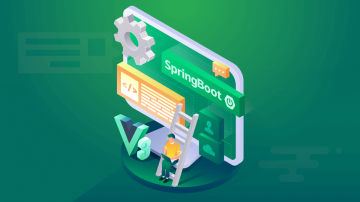本文详细介绍了Spring Boot项目开发的基础知识,包括环境搭建、项目创建、核心配置、Web开发、数据库集成、日志和异常处理等内容。通过这些内容的学习,开发者可以快速上手Spring Boot,开发出高效简洁的应用程序。文章涵盖了从环境搭建到项目部署的全过程,提供了丰富的示例和配置说明。
Spring Boot 简介什么是Spring Boot
Spring Boot 是一个基于Spring框架的简化配置工具,它通过自动配置、自动装配和约定优于配置的原则,帮助开发者快速搭建独立运行的Spring应用程序。Spring Boot 的主要目标是提供一种更快、更简洁的方式来创建独立的、生产级别的Spring应用程序,能够快速启动并运行,同时保持代码的可维护性和可扩展性。Spring Boot 的核心在于它能够自动地配置Spring应用的大部分组件,减少了开发者在配置文件上的投入时间。
Spring Boot 的优势
- 简化开发:Spring Boot 可以自动配置Spring应用程序的大部分组件,简化了开发者的配置工作。
- 快速启动:Spring Boot 通过自动配置和其他最佳实践,使得创建新的Spring应用程序变得简单快捷。
- 独立运行:Spring Boot 应用程序可以独立运行,不需要外部的Web容器(如Tomcat),因为Spring Boot 内置了这些容器。
- 无代码生成:Spring Boot 不需要开发者生成大量的XML配置文件,提倡使用Java配置类或属性文件,减少了代码量。
- 约定优于配置:Spring Boot 提供了一套约定的配置,使得开发者只需要按照约定即可快速编写应用程序。
- 嵌入式服务器:Spring Boot 可以使用嵌入式的Tomcat、Jetty或Undertow服务器,简化了部署和管理过程。
- 集成第三方库:Spring Boot 可以便捷地集成各种第三方库,如JPA、MyBatis、RabbitMQ等。
- 自动配置:Spring Boot 可以自动配置很多Spring组件,例如数据源、异常处理、日志等。
- 健康检查:Spring Boot 提供了内置的健康检查(/health)和监控(/metrics)端点,用于检查应用程序的运行状态。
- 打包与运行:Spring Boot 提供了内置的打包工具(如Spring Boot Maven插件)和运行工具,使得打包和运行应用程序变得更加简单。
Spring Boot 的环境搭建
环境要求
- JDK版本:建议使用JDK 8或更高版本。
- IDE:推荐使用IntelliJ IDEA或Spring Tools Suite,它们对Spring Boot有很好的支持。
- Maven或Gradle:用于管理项目依赖和构建。
安装JDK
- 访问Oracle官方JDK或OpenJDK下载页面,下载对应版本的JDK。
- 按照安装向导安装JDK。
- 验证安装,打开命令行,输入
java -version和javac -version,查看版本信息。
安装IDE
-
IntelliJ IDEA:
- 访问官网下载页面,下载对应版本的IDEA。
- 按照安装向导安装IDEA。
- 打开IDEA,进入设置(File -> Settings),在Plugins中搜索Spring来安装Spring插件。
- Spring Tools Suite:
- 访问官网下载页面,下载对应版本的STS。
- 按照安装向导安装STS。
- 打开STS,进入Preferences,添加Spring Boot支持。
创建Spring Boot项目
- 打开IDE,通过STS或Spring Initializr创建新的Spring Boot项目。
- 在STS中,选择File -> New -> Spring Starter Project。
- 在Spring初始页面中输入项目名称、语言、依赖等信息,点击Next按钮。
- 选择需要的依赖,如Spring Web、Spring Data JPA、Thymeleaf等。
- 完成配置后,点击Finish按钮完成项目创建。
创建Spring Boot项目
创建一个新的Spring Boot项目,可以通过STS或Spring Initializr进行。
import org.springframework.boot.SpringApplication;
import org.springframework.boot.autoconfigure.SpringBootApplication;
@SpringBootApplication
public class MySpringBootApplication {
public static void main(String[] args) {
SpringApplication.run(MySpringBootApplication.class, args);
}
}在上述代码中,@SpringBootApplication注解是Spring Boot的核心注解,它集成了@Configuration、@EnableAutoConfiguration和@ComponentScan三个注解,用于开启自动配置、组件扫描等功能。
Spring Boot项目的目录结构
一个典型的Spring Boot项目结构如下:
src
└── main
├── java
│ └── com
│ └── example
│ └── myapp
│ └── MySpringBootApplication.java
├── resources
│ ├── application.properties
│ ├── static
│ └── templatesapplication.properties:Spring Boot的配置文件。static:存放静态资源文件,如HTML、CSS、JS等。templates:存放模板文件,如Thymeleaf模板。MySpringBootApplication.java:Spring Boot应用程序的入口类。
运行第一个Spring Boot应用
启动项目,需要执行MySpringBootApplication类中的main方法。
import org.springframework.boot.SpringApplication;
import org.springframework.boot.autoconfigure.SpringBootApplication;
@SpringBootApplication
public class MySpringBootApplication {
public static void main(String[] args) {
SpringApplication.run(MySpringBootApplication.class, args);
}
}运行后,控制台会输出启动日志,说明应用已经成功启动。默认情况下,Spring Boot 应用会启动一个嵌入式的Tomcat服务器,并监听8080端口。可以通过访问http://localhost:8080来验证应用是否运行正常。
应用配置文件
Spring Boot 使用 application.properties 或 application.yml 文件来配置应用。
# application.properties
server.port=8081
spring.application.name=myapp
spring.datasource.url=jdbc:mysql://localhost:3306/mydb
spring.datasource.username=root
spring.datasource.password=root配置属性的使用
在Java代码中,可以通过@Value注解来注入配置属性。
import org.springframework.beans.factory.annotation.Value;
import org.springframework.stereotype.Component;
@Component
public class AppConfig {
@Value("${server.port}")
private String serverPort;
public String getServerPort() {
return serverPort;
}
}配置文件的优先级
Spring Boot 的配置文件优先级从高到低如下:
- 命令行参数
- Java System Properties
- 操作系统的环境变量
application.properties或application.yml文件默认配置
创建RESTful服务
创建一个RESTful服务,可以通过@RestController注解来定义控制器类。
import org.springframework.web.bind.annotation.GetMapping;
import org.springframework.web.bind.annotation.RestController;
@RestController
public class MyController {
@GetMapping("/hello")
public String sayHello() {
return "Hello, Spring Boot!";
}
}使用Spring MVC注解
Spring Boot 使用Spring MVC作为Web层的基础框架,通过注解(如@RestController、@GetMapping等)来简化Web应用的开发。
import org.springframework.web.bind.annotation.GetMapping;
import org.springframework.web.bind.annotation.RestController;
@RestController
public class MyController {
@GetMapping("/hello")
public String sayHello() {
return "Hello, Spring Boot!";
}
}模板引擎简介及使用
Spring Boot 支持多种模板引擎,如Thymeleaf、FreeMarker等。这里以Thymeleaf为例。
<!-- templates/hello.html -->
<!DOCTYPE html>
<html xmlns:th="http://www.thymeleaf.org">
<head>
<title>Hello</title>
</head>
<body>
<h1 th:text="'Hello, ' + ${name}"></h1>
</body>
</html>import org.springframework.web.bind.annotation.GetMapping;
import org.springframework.web.bind.annotation.RestController;
import org.springframework.web.servlet.ModelAndView;
@RestController
public class MyController {
@GetMapping("/hello")
public ModelAndView sayHello() {
ModelAndView modelAndView = new ModelAndView("hello");
modelAndView.addObject("name", "Spring Boot");
return modelAndView;
}
}Spring Boot集成JPA
JPA(Java Persistence API)是Java EE规范的一部分,用于对象关系映射。Spring Boot 通过Spring Data JPA 提供了对JPA的支持。
import javax.persistence.Entity;
import javax.persistence.GeneratedValue;
import javax.persistence.GenerationType;
import javax.persistence.Id;
@Entity
public class User {
@Id
@GeneratedValue(strategy = GenerationType.IDENTITY)
private Long id;
private String name;
private String email;
// getters and setters
public Long getId() {
return id;
}
public void setId(Long id) {
this.id = id;
}
public String getName() {
return name;
}
public void setName(String name) {
this.name = name;
}
public String getEmail() {
return email;
}
public void setEmail(String email) {
this.email = email;
}
}数据库连接配置
在application.properties中配置数据库连接信息。
# application.properties
spring.datasource.url=jdbc:mysql://localhost:3306/mydb
spring.datasource.username=root
spring.datasource.password=root
spring.jpa.hibernate.ddl-auto=update实体类和Repository使用
定义一个UserRepository接口,继承JpaRepository接口。
import org.springframework.data.jpa.repository.JpaRepository;
public interface UserRepository extends JpaRepository<User, Long> {
}使用UserRepository在服务类中进行数据库操作。
import org.springframework.beans.factory.annotation.Autowired;
import org.springframework.stereotype.Service;
@Service
public class UserService {
private final UserRepository userRepository;
@Autowired
public UserService(UserRepository userRepository) {
this.userRepository = userRepository;
}
public User saveUser(User user) {
return userRepository.save(user);
}
}Spring Boot的日志配置
Spring Boot 通过application.properties文件配置日志系统。
# application.properties
logging.level.root=INFO
logging.level.com.example=DEBUG异常处理机制
Spring Boot 提供了强大的异常处理机制,可以通过@ControllerAdvice注解来全局处理异常。
import org.springframework.web.bind.annotation.ControllerAdvice;
import org.springframework.web.bind.annotation.ExceptionHandler;
import org.springframework.web.bind.annotation.ResponseBody;
import org.springframework.web.bind.annotation.ResponseStatus;
@ControllerAdvice
public class GlobalExceptionHandler {
@ExceptionHandler(value = {Exception.class})
@ResponseBody
@ResponseStatus(HttpStatus.INTERNAL_SERVER_ERROR)
public String handleException(Exception e) {
return "An error occurred: " + e.getMessage();
}
}自定义异常处理类
可以创建自定义的异常类,并在全局异常处理器中进行处理。
public class MyException extends RuntimeException {
public MyException(String message) {
super(message);
}
}@ControllerAdvice
public class GlobalExceptionHandler {
@ExceptionHandler(value = {MyException.class})
@ResponseBody
@ResponseStatus(HttpStatus.INTERNAL_SERVER_ERROR)
public String handleMyException(MyException e) {
return "My custom exception: " + e.getMessage();
}
}Logback配置文件示例
<configuration>
<appender name="STDOUT" class="ch.qos.logback.core.ConsoleAppender">
<encoder>
<pattern>%d{yyyy-MM-dd HH:mm:ss} - %msg%n</pattern>
</encoder>
</appender>
<logger name="com.example" level="DEBUG"/>
<root level="INFO">
<appender-ref ref="STDOUT"/>
</root>
</configuration>本教程详细介绍了Spring Boot的基础知识,包括环境搭建、创建第一个项目、核心配置、Web开发、数据库集成、日志和异常处理等内容。通过这些内容的学习,读者可以快速上手Spring Boot,开发出高效、简洁的Spring应用。建议读者在学习过程中,多动手实践,并参考Spring Boot官方文档和在线教程,加深对Spring Boot的理解和应用。

 随时随地看视频
随时随地看视频




